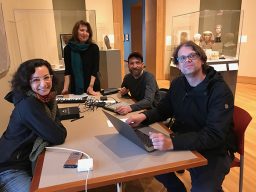Meet the Artists Behind the Bowdoin College Museum of Art’s New Commissions, “Let’s Get Lost” and “Listening Glass”: linn meyers, Rebecca Bray, James Bigbee Garver, and Josh Knowles
By Bowdoin College Museum of Art
On September 27, the Museum of Art will open a collaborative, site-specific, multi-media art installation featuring a large-scale wall drawing entitled Let’s Get Lost by linn meyers, a Washington, D.C.-based contemporary artist. meyers will also serve as the 2018-2019 halley k harrisburg ’90 and Michael Rosenfeld Artist-in-Residence at the College. This important residency will enable students to get to know and learn from meyers over the course of the coming academic year.
Concurrently, sound artists Rebecca Bray, James Bigbee Garver, and Josh Knowles will premiere, in partnership with meyers, an interactive sound installation, Listening Glass, that corresponds with the wall drawing and features acoustic components activated through audience participation. The work grows out of preparatory visits made by the artists to campus, during which time they met with students, faculty, and staff. Exciting opportunities exist for emerging musicians and dancers to develop their own responses to the installation, which will effectively transform the Museum’s Walker Gallery into a musical instrument. Let’s Get Lost and Listening Glass will be on view through September 29, 2019. This ground-breaking commission was made possible by a gift from David and Barbara Roux.
The artists linn meyers, Rebecca Bray, James Bigbee Garver, and Josh Knowles recently shared their insights on the work. Please join us for an opportunity to meet them in person in late September during festivities that surround the launch of this collaboration.
How did this collaboration originate?
We started our collaboration after Garver and Bray created an interactive audio work, Framing Device, in 2016 for the Sound Scene Festival at Washington DC’s Hirshhorn Museum. Framing Device was an audio and performance piece done in response to meyers’s large-scale site-specific drawing, Our View From Here, installed on the walls of the Hirshhorn’s second floor. The extremely positive public reception to the piece – an unusual interplay between audio and visual art – prompted the artists to join forces and bring in Knowles, a game designer, interaction designer, and creative programmer. The four of us began to envision a piece that would meet our collective goal of creating a work that invites audiences to collaboratively discover new kinds of relationships between their bodies, art, sound, and space.
Can you describe the artistic process behind these works? How have Let’s Get Lost and Listening Glass developed simultaneously?
Our work relies on radical collaboration. The team of four artists (sound designer/composer, technologist, visual artist, experience designer/installation artist) bring their various talents to the project, striving to create something that we have never seen before. Let’s Get Lost has required a substantial amount of collaborative experimentation to refine all the interrelated components of the piece: handheld device, sounds, audiences, and drawing. Through workshops, videos, shared documentation, and user testing with audiences, the two pieces have evolved together as the artists tested the balance between the media and prodded constraints.
Meyers’s approach to image-making depends on a delicate balance between the planned and the accidental – she begins her large-scale drawings after having spent months planning the compositions, and then invites accident and entropy to change the way that the images evolve on-site. Pre-determined compositions and an openness to chance have also played a pivotal role in the way that Listening Glass has developed among the four of us. Visitors to the gallery will mirror this approach, as they improvise while interacting with the wall drawing and the handheld device.
What are its particular innovations?
We are passionate about examining how we collaborate with audiences and how they are instrumental in developing and refining an interactive art piece. We are very excited about the democratization of creative tools and appreciate that music, visual art, and many other art forms are increasingly accessible to people the world over. We want to play a role in the development of sophisticated points of access that empower people to create without formal training.
On what type of mobile device will audiences be able to access it?
The app will run on any iPhone or iPad manufactured in the past two years and will be downloadable from the app store. Some iPhone devices will be available at the museum for audiences who do not bring their own. Viewers who are not at the gallery space will be able to view information about the project in the app. To use the actual Listening Glass audio features, viewers will need to be at the exhibition space.
Meet the artists in person at the following events!
Wednesday, September 26 at 7:30 pm, linn meyers, halley k harrisburg ’90 and Michael Rosenfeld Artist-in-Residence: “Let’s Get Lost: Finding One’s Path as an Artist,” Kresge Auditorium, Visual Arts Center.
Thursday, September 27, 2018, 5:00–6:30 pm, Opening Reception for “Let’s Get Lost” and “Listening Glass” at the Bowdoin College Museum of Art.
Friday, September 28, 12:00 noon–1:00 pm, linn meyers, Rebecca Bray, James Bigbee Garver, and Josh Knowles: “Creative Collaboration in Line, Sound, and Gesture,” Bowdoin College Museum of Art.